Effects of Cracking Test Conditions on Estimation Uncertainty for Weibull Parameters Considering Time-Dependent Censoring Interval
Abstract
:1. Introduction
- In the previous study, it was assumed that LCI was a time-independent variable. However, time-dependent LCI is more general for real SCC tests. Thus, it is necessary to investigate the effect of time dependence on LCI.
- In the previous study, it was not appropriate to use the test duration as an experimental factor of estimation uncertainty because it is not possible for experimenters to know the relative test duration (RTD). Additionally, it was possible to continue the simulation even after all of the specimens cracked if the test duration was used as a fixed input for the simulation study [12].
2. Theoretical Background of the Weibull Distribution
2.1. Extremal Types Theorem
- If the unbounded lower tail of a parent distribution is light-tailed (i.e., falls off exponentially or faster [16]), then the distribution of sample minima is approximated to a Type I extreme value distribution for minima (Type I EVDm, i.e., the smallest extreme value distribution) that has an unbounded domain.
- the unbounded lower tail of the parent distribution is heavy-tailed, then the distribution of the sample minima is approximated to a Type II EVDm (i.e., reversed Fréchet distribution) that has an upper bound.
- the lower tail of the parent distribution is bounded (e.g., uniform distribution), then the distribution of the sample minima is approximated to a Type III EVDm (i.e., Weibull distribution) that has a lower bound.
2.2. Weibull Distribution
- Type I EVDm: smallest extreme value distribution ():
- Type II EVDm: reversed Fréchet distribution ():
- Type III EVDm: Weibull distribution ():where denotes the variable, denotes the location parameter, denotes the scale parameter and denotes the shape parameter. The type of EVD is determined by the sign of .
2.3. Estimation of Weibull Parameters
3. Monte Carlo Simulation
3.1. Experimental Factors
3.1.1. True Weibull Parameters
3.1.2. Number of Specimens
3.1.3. End Cracking Fraction
3.1.4. Length of Censoring Interval
3.2. Simulation Approach
4. Results and Discussion
4.1. Mean Number of Censoring
4.2. Mean Test Duration
4.3. Empirical Confidence Interval of
4.4. Empirical Confidence Interval of
5. Conclusions
- The Weibull distribution was appropriate for the statistical model of cracking time at a macroscopic scale.
- The application of the same MNC line was reasonable as a criterion of uncertainty comparison between the TILCI and TDLCI cases. In this criterion, there was interestingly no (or very little) difference between the estimation uncertainty with the TILCI scheme and that with the TDLCI scheme.
- The branch point of the ECF with respect to the value of on MTD is suspected to be 0.632 (=). For the case when the value of ECF was relatively low, a non-consistent effect of starting LCI on MTD was observed.
- In most cases, and showed a tendency to be overestimated and dispersed when the number of specimens was small and the value of ECF was low. It was difficult to find the general effect of and starting LCI due to the occurrence of strange valleys. It was shown that there were critical regions in which the estimators, whose dispersions were extremely large, were produced. Thus, the study recommends that experimenters should avoid this region.
- showed almost zero bias in all simulation ranges. Conversely, could be overestimated in some cases. Both and tended to be dispersed when: (1) the number of specimens was small; (2) the value of ECF was small; and (3) the value of was small. In most cases, the starting LCI did not affect the estimation uncertainty of .
- The overall bias and dispersion of were much lower than those of in the simulation study range.
Supplementary Materials
Acknowledgments
Author Contributions
Conflicts of Interest
References
- Lunceford, W.; DeWees, T.; Scott, P. EPRI Materials Degradation Matrix, Revision 3; Electric Power Research Institute (EPRI): Palo Alto, CA, USA, 2013. [Google Scholar]
- Scott, P.; Meunier, M.C. Materials Reliability Program: Review of Stress Corrosion Cracking of Alloys 182 and 82 in PWR Primary Water Service (MRP-220); Report No. 1015427; Electric Power Research Institute (EPRI): Palo Alto, CA, USA, 2007. [Google Scholar]
- Kim, K.J.; Do, E.S. Technical Report: Inspection of Bottom Mounted Instrumentation Nozzle (in Korean); KINS/RR-1360; Korea Institute of Nuclear Safety (KINS): Daejeon, Korea, 2015. [Google Scholar]
- Amzallag, C.; Hong, S.L.; Pages, C.; Gelpi, A. Stress Corrosion Life Assessment of Alloy 600 PWR Components. In Ninth International Symposium on Environmental Degradation of Materials in Nuclear Power Systems—Water Reactors; The Minerals Metals and Materials Society: Newport Beach, CA, USA, 1999; pp. 243–250. [Google Scholar]
- Garud, Y.S. Stress Corrosion Cracking Initiation Model for Stainless Steel and Nickel Alloys; Electric Power Research Institute (EPRI): Palo Alto, CA, USA, 2009. [Google Scholar]
- Erickson, M.; Ammirato, F.; Brust, B.; Dedhia, D.; Focht, E.; Kirk, M.; Lange, C.; Olsen, R.; Scott, P.; Shim, D.; et al. Models and Inputs Selected for Use in the xLPR Pilot Study; Electric Power Research Institute (EPRI): Palo Alto, CA, USA, 2011. [Google Scholar]
- Troyer, G.; Fyfitch, S.; Schmitt, K.; White, G.; Harrington, C. Dissimilar Metal Weld PWSCC Initiation Model Refinement for xLPR Part I: A Survey of Alloy 82/182/132 Crack Initiation Literature. In Proceedings of the 17th International Conference on Environmental Degradation of Materials in Nuclear Power Systems—Water Reactors, Ottawa, ON, Canada, 9–13 August 2015.
- Weibull, W. A Statistical Theory of the Strength of Materials; Generalstabens Litografiska Anstalts Förlag: Stockholm, Sweden, 1939. [Google Scholar]
- Eason, E. Materials Reliability Program: Effects of Hydrogen, pH, Lithium and Boron on Primary Water Stress Corrosion Crack Initiation in Alloy 600 for Temperatures in the Range 320–330 °C (MRP-147); Electric Power Research Institute (EPRI): Palo Alto, CA, USA, 2005. [Google Scholar]
- Hwang, I.S.; Kwon, S.U.; Kim, J.H.; Lee, S.G. An Intraspecimen Method for the Statistical Characterization of Stress Corrosion Crack Initiation Behavior. Corrosion 2001, 57, 787–793. [Google Scholar] [CrossRef]
- McCool, J. Using the Weibull Distribution: Reliability, Modeling, and Inference; John Wiley & Sons: Hoboken, NJ, USA, 2012. [Google Scholar]
- Park, J.P.; Bahn, C.B. Uncertainty Evaluation of Weibull Estimators through Monte Carlo Simulation: Applications for Crack Initiation Testing. Materials 2016, 9, 521. [Google Scholar] [CrossRef]
- Ross, S.M. Introduction to Probability and Statistics for Engineers and Scientists, 4th ed.; Elsevier Academic Press: Atlanta, GA, USA, 2009. [Google Scholar]
- Fisher, R.A.; Tippett, L.H.C. Limiting Forms of the Frequency Distribution of the Largest or Smallest Member of a Sample. In Mathematical Proceedings of the Cambridge Philosophical Society; Cambridge University Press: Cambridge, UK, 1928; pp. 180–190. [Google Scholar]
- Gnedenko, B.V. On a Local Limit Theorem of the Theory of Probability. Uspekhi Matematicheskikh Nauk 1948, 3, 187–194. [Google Scholar]
- Wolpert, R.L. Extremes. Available online: https://www2.stat.duke.edu/courses/Fall15/sta711/lec/topics/extremes.pdf (accessed on 2 August 2016).
- McFadden, D. Modeling the Choice of Residential Location. Transp. Res. Rec. 1978, 673, 72–77. Available online: http://onlinepubs.trb.org/Onlinepubs/trr/1978/673/673-012.pdf (accessed on 2 August 2016). [Google Scholar]
- Hampel, F.R.; Ronchetti, E.M.; Rousseeuw, P.J.; Stahel, W.A. Robust Statistics: The Approach Based on Influence Functions; John Wiley & Sons: Hoboken, NJ, USA, 2011; Volume 114. [Google Scholar]
- Genschel, U.; Meeker, W.Q. A Comparison of Maximum Likelihood and Median-Rank Regression for Weibull Estimation. Qual. Eng. 2010, 22, 236–255. [Google Scholar] [CrossRef]
- Hong, J.D.; Jang, C.; Kim, T.S. PFM Application for the PWSCC Integrity of Ni-Base Alloy Welds—Development and Application of PINEP-PWSCC. Nuclear Eng. Technol. 2012, 44, 961–970. [Google Scholar] [CrossRef]
- Dozaki, K.; Akutagawa, D.; Nagata, N.; Takihuchi, H.; Norring, K. Effects of Dissolved Hydrogen Condtent in PWR Primary Water on PWSCC Initiation Property. E-J. Adv. Maint. 2010, 2, 65–76. [Google Scholar]
- Garud, Y.S. SCC Initiation Model and Its Implementation for Probabilistic Assessment. In Proceedings of the ASME 2010 Pressure Vessels & Piping Division, Bellevue, WA, USA, 18–22 July 2010.
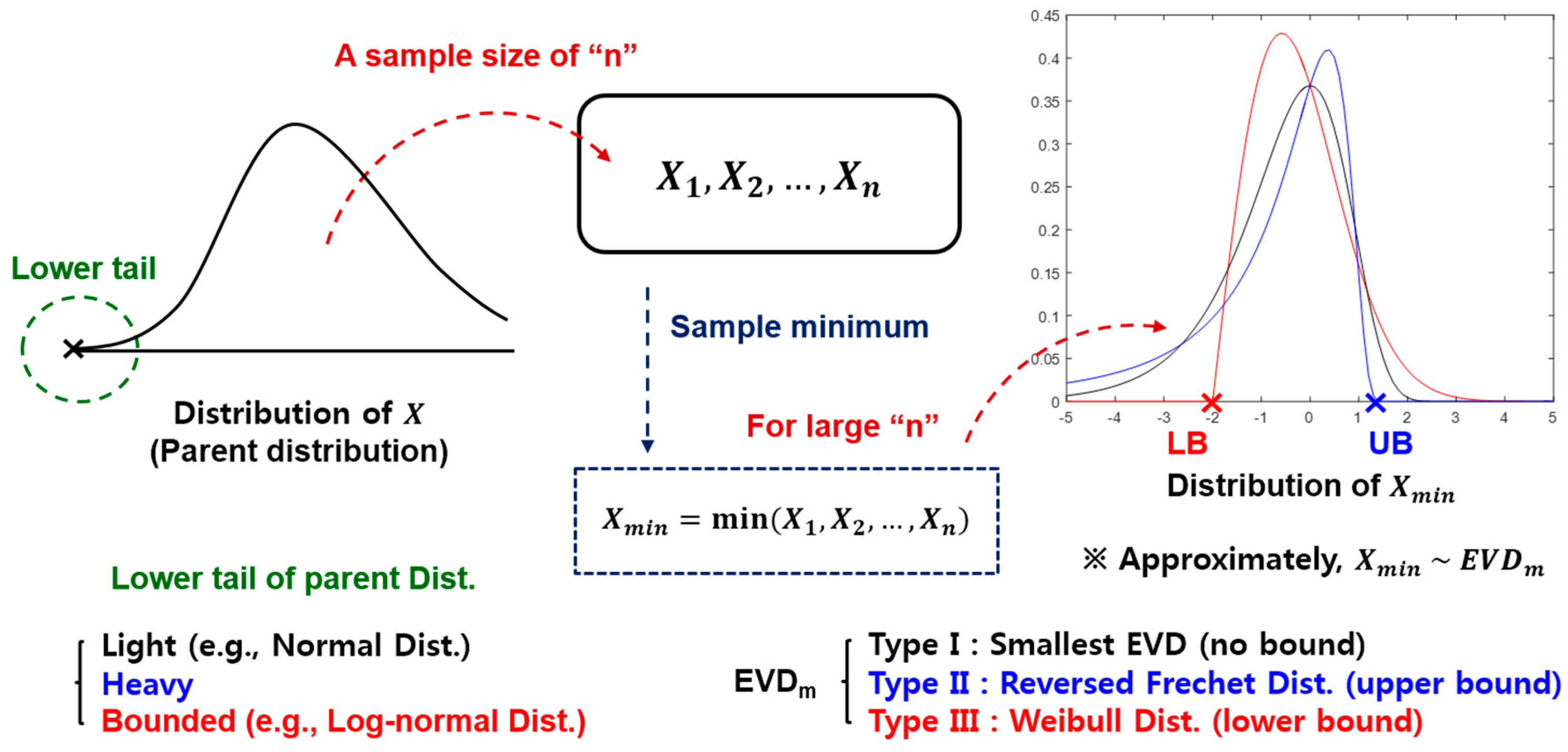
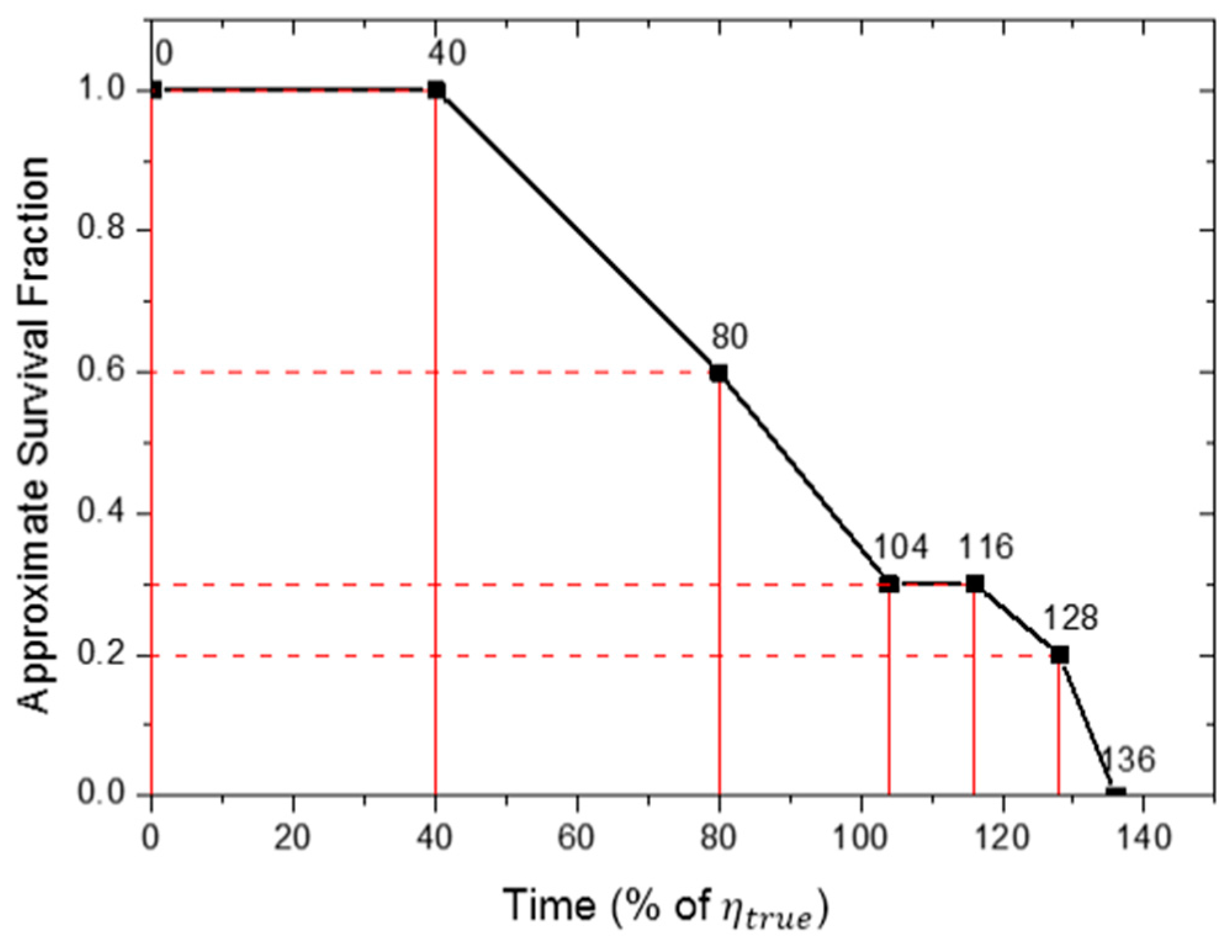
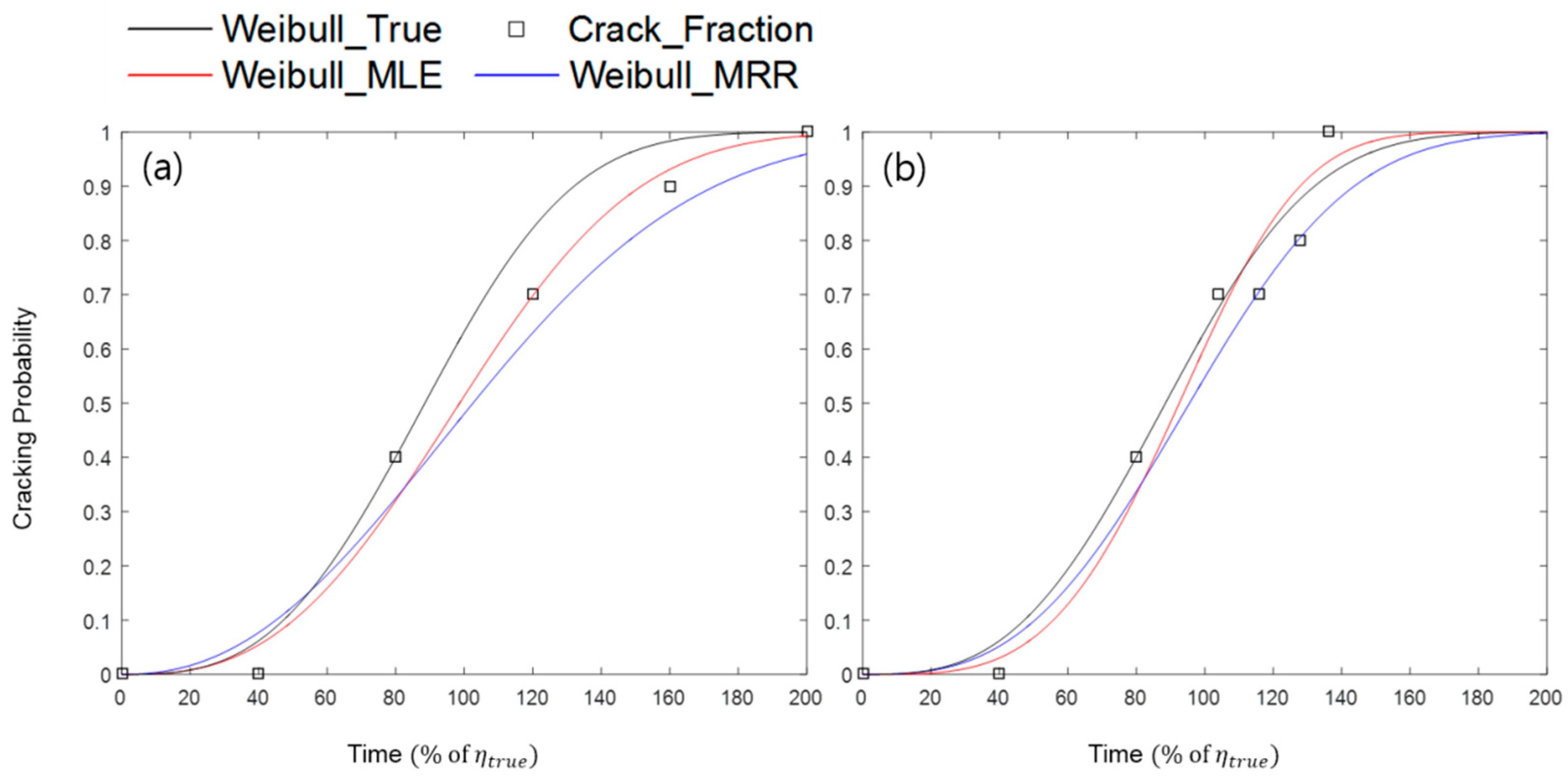
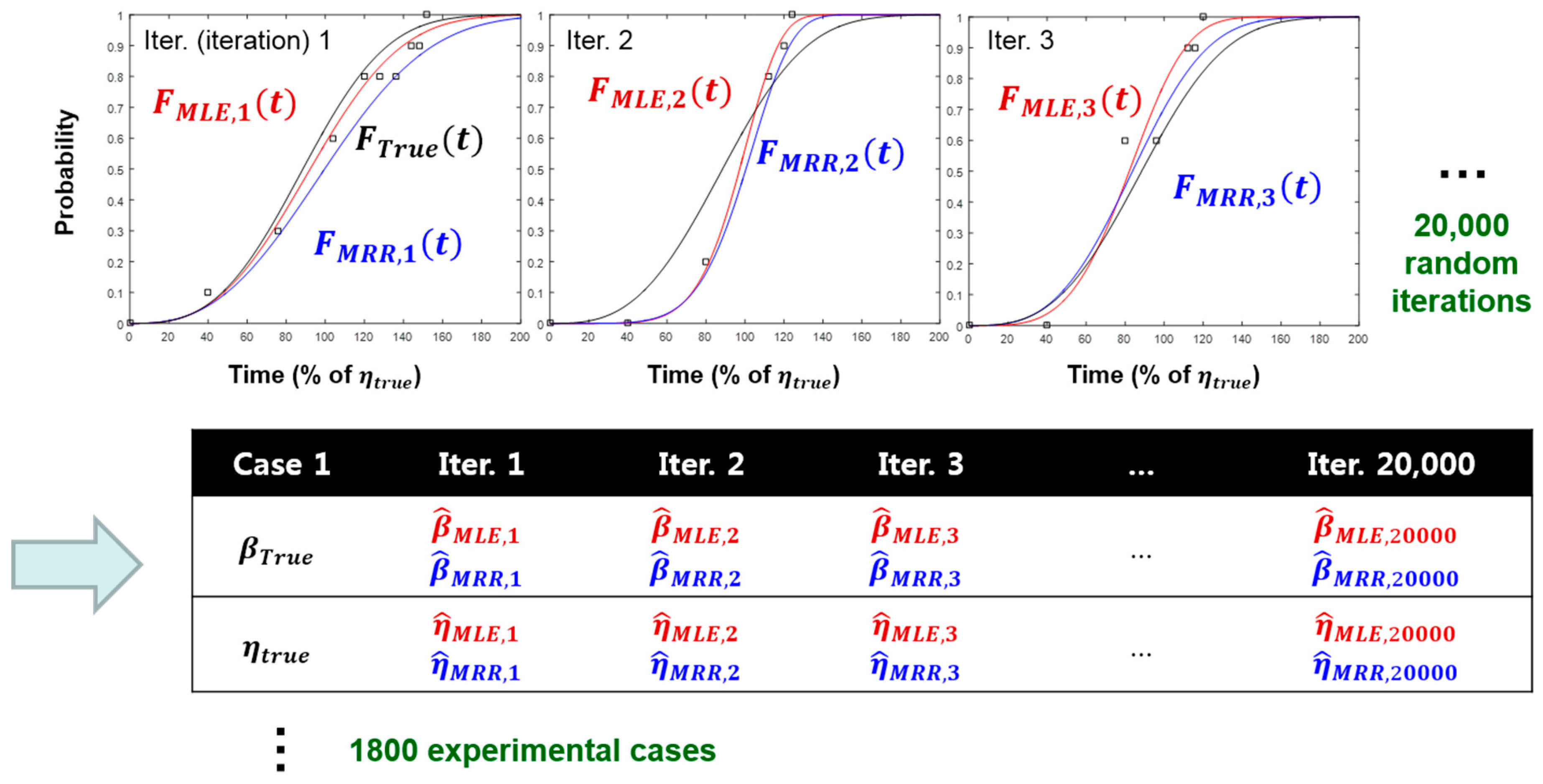
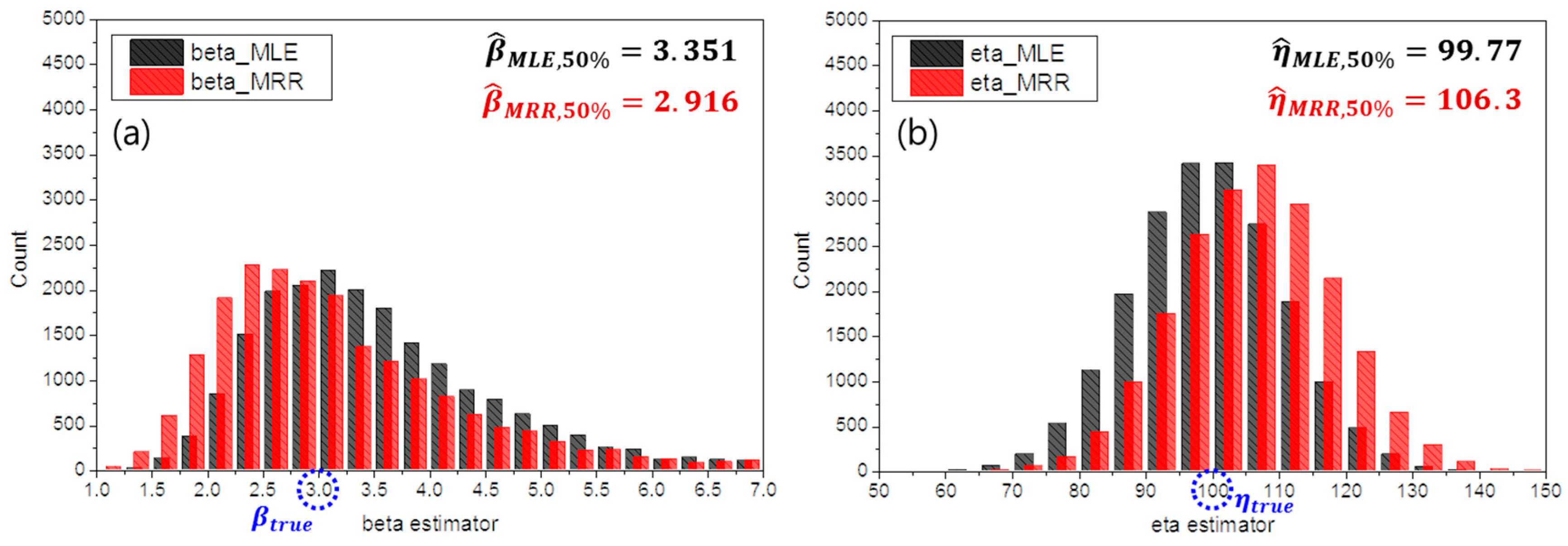
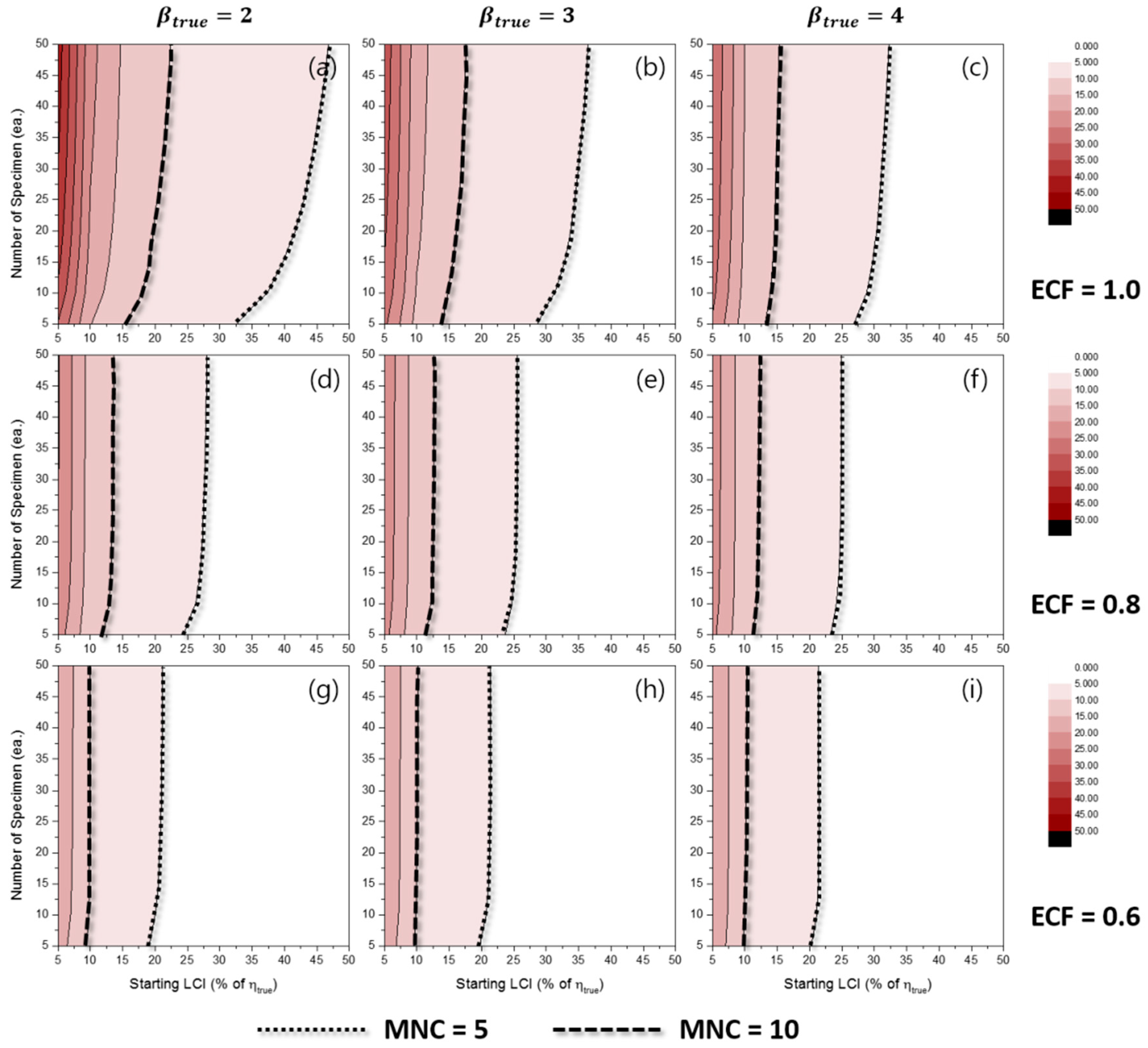
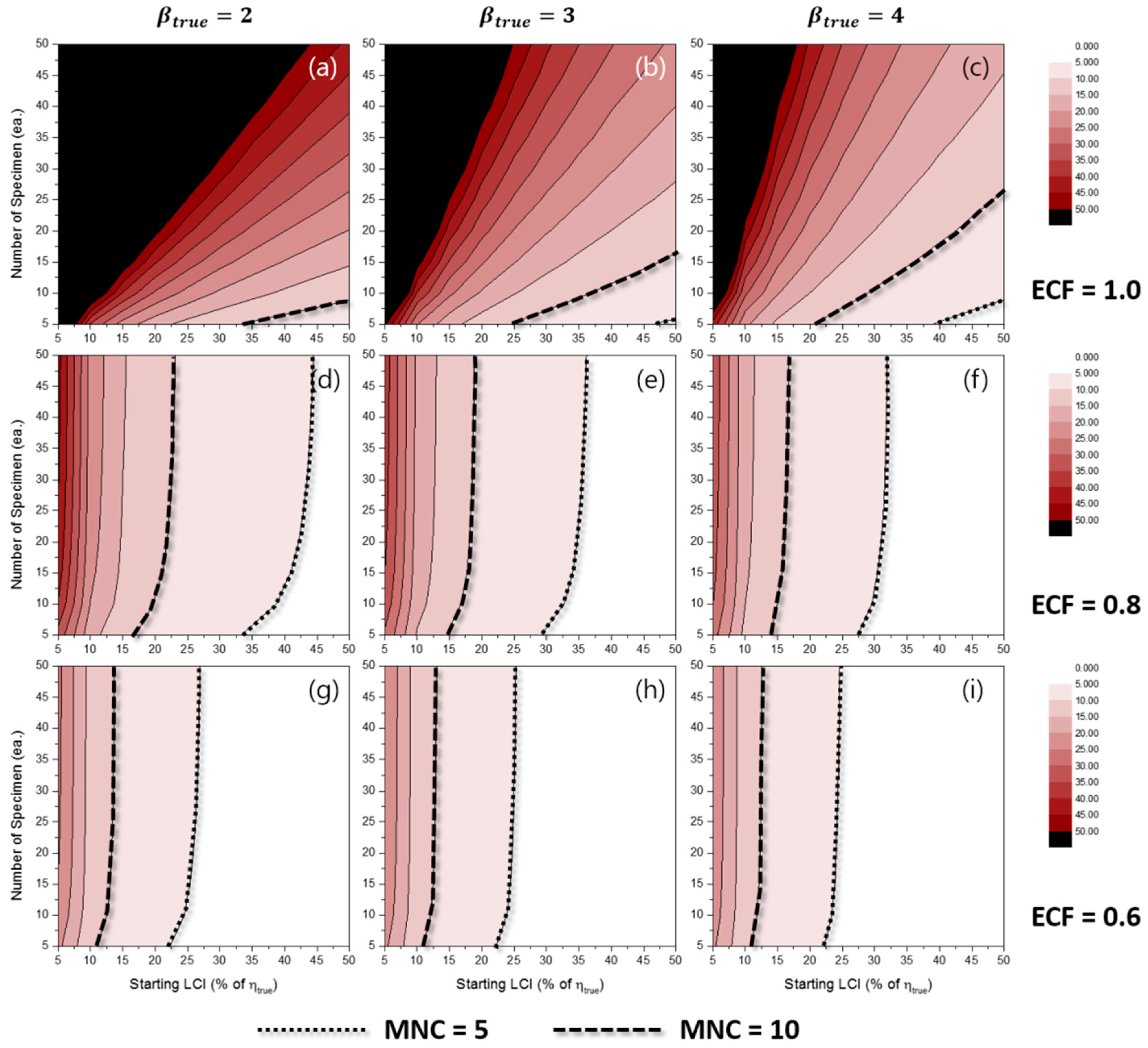
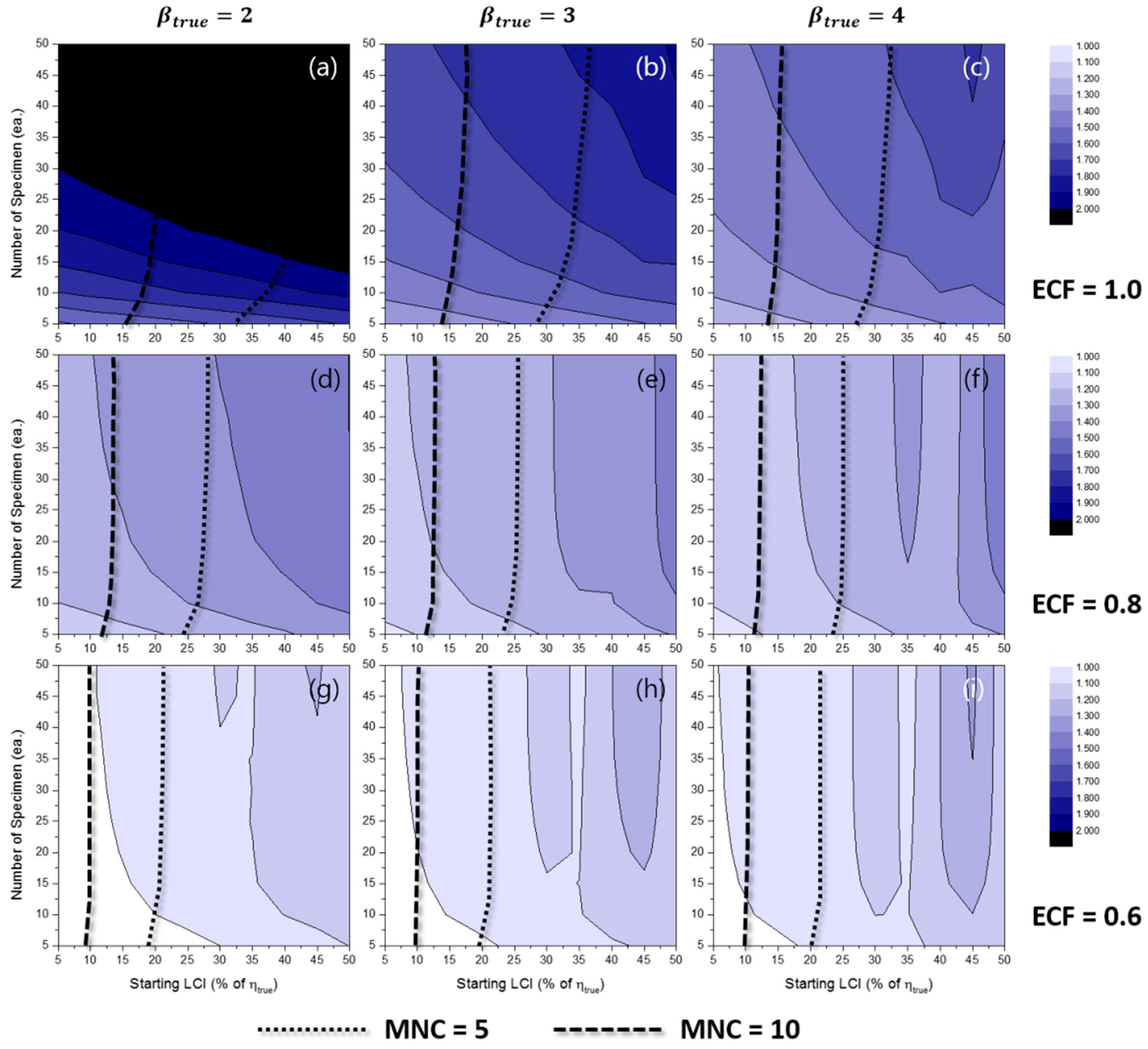

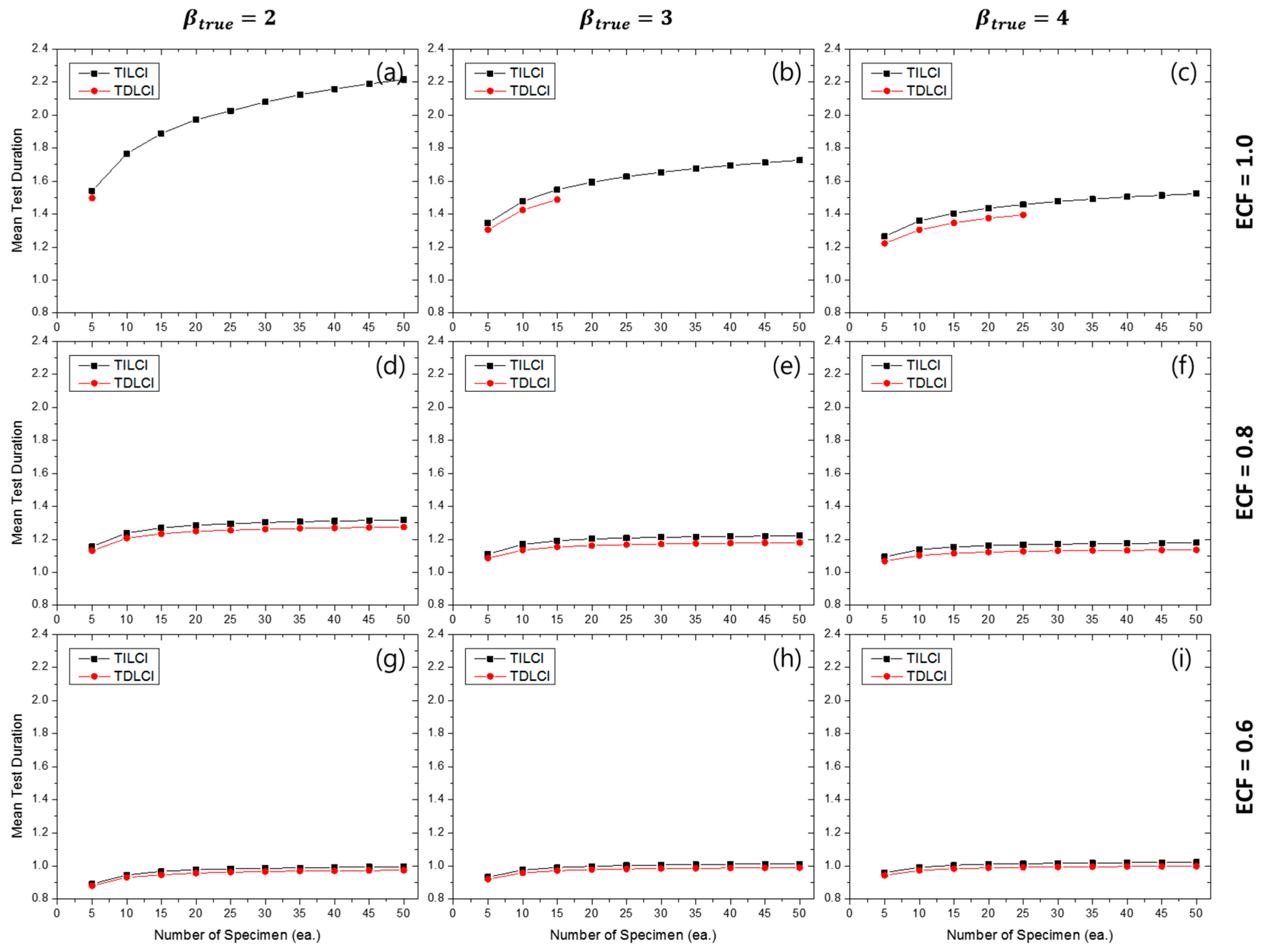
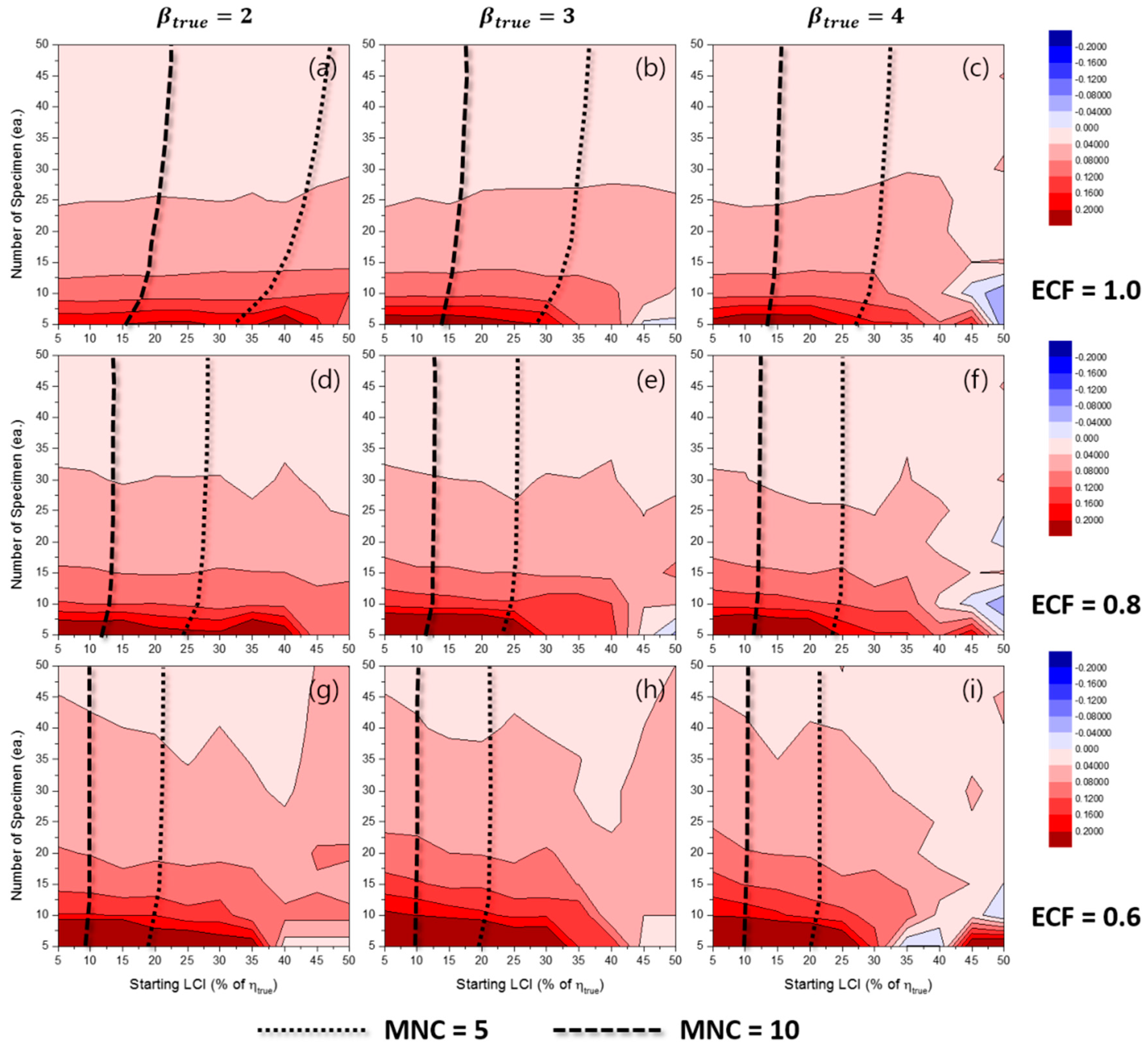
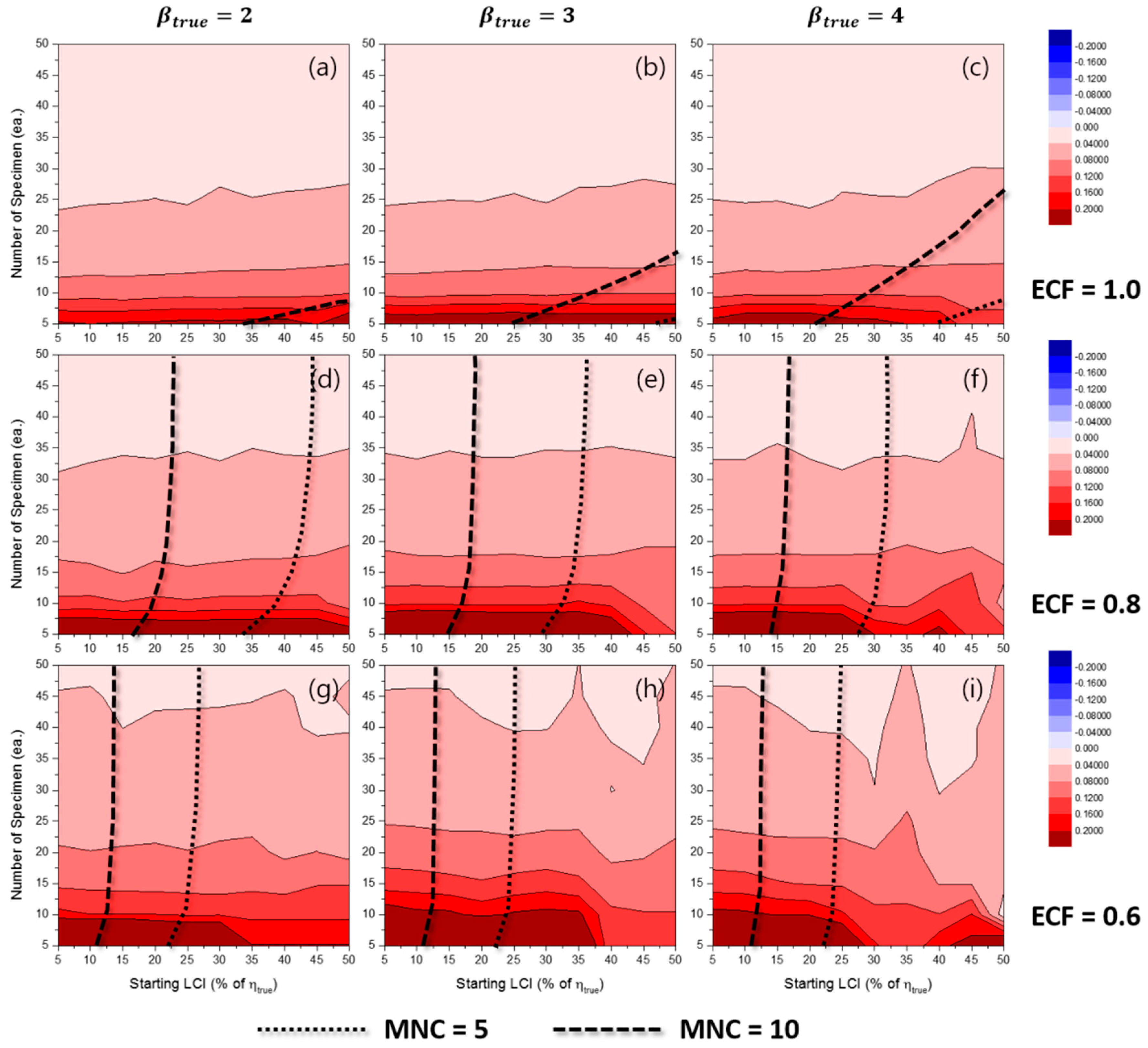

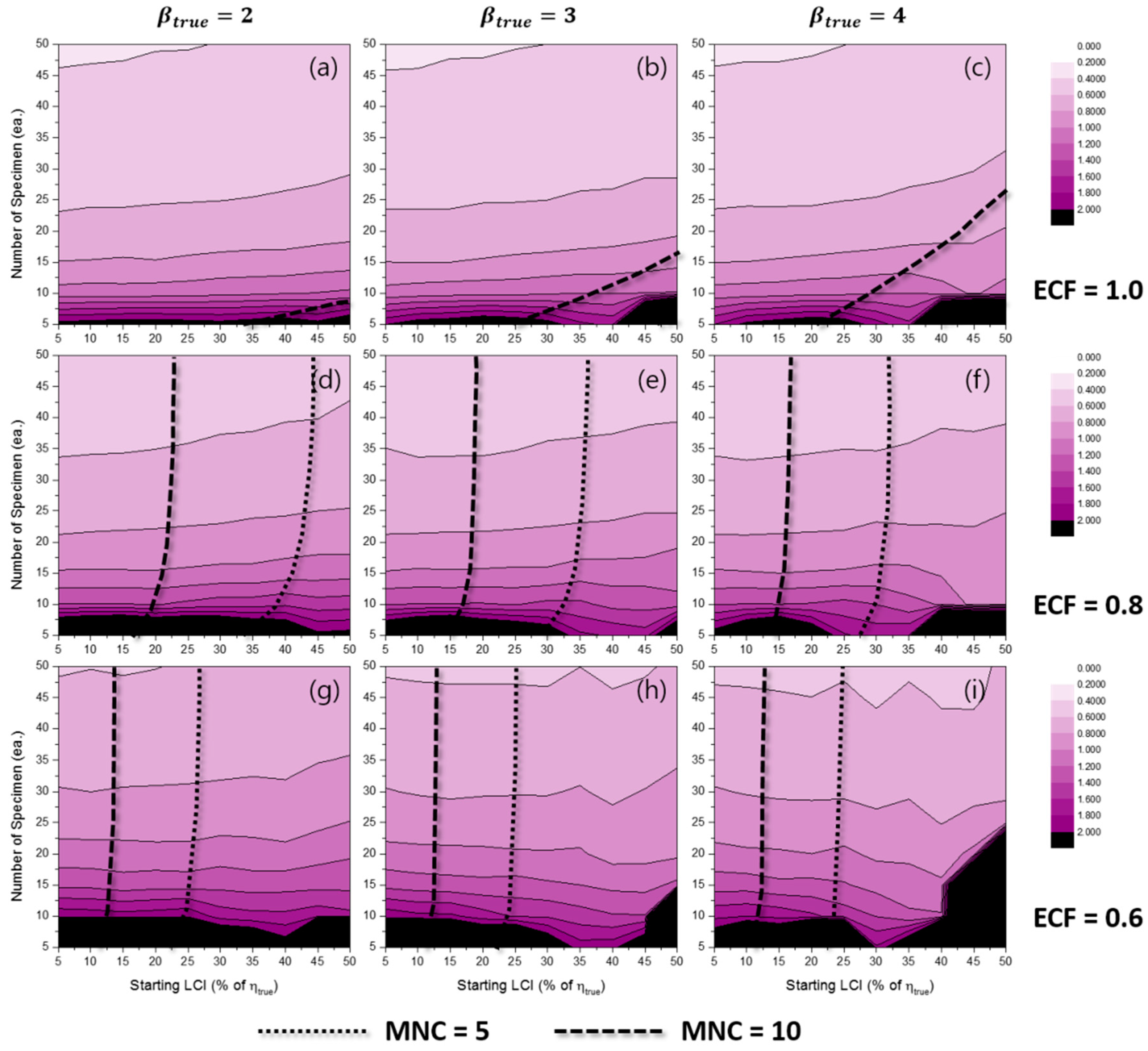
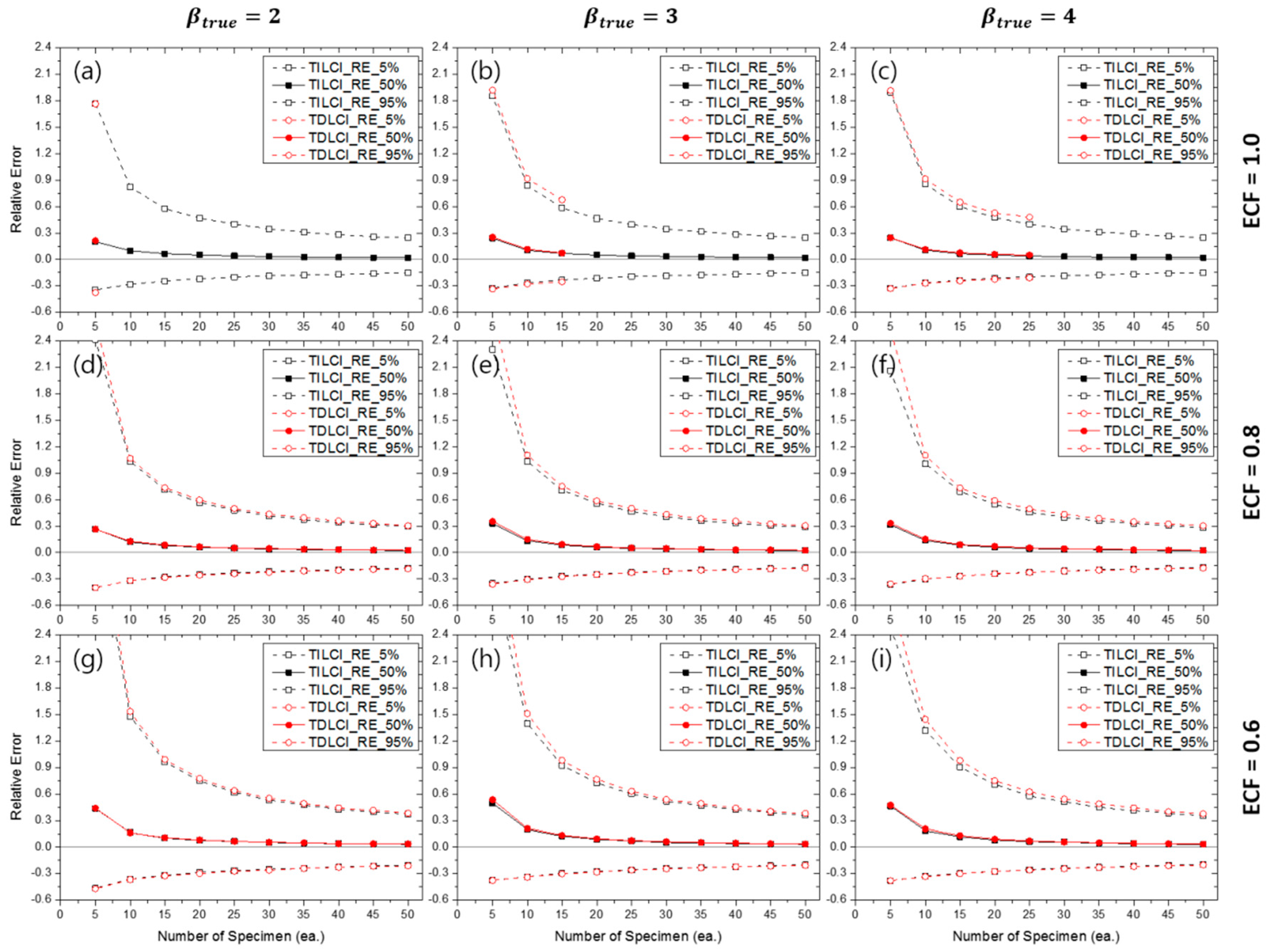
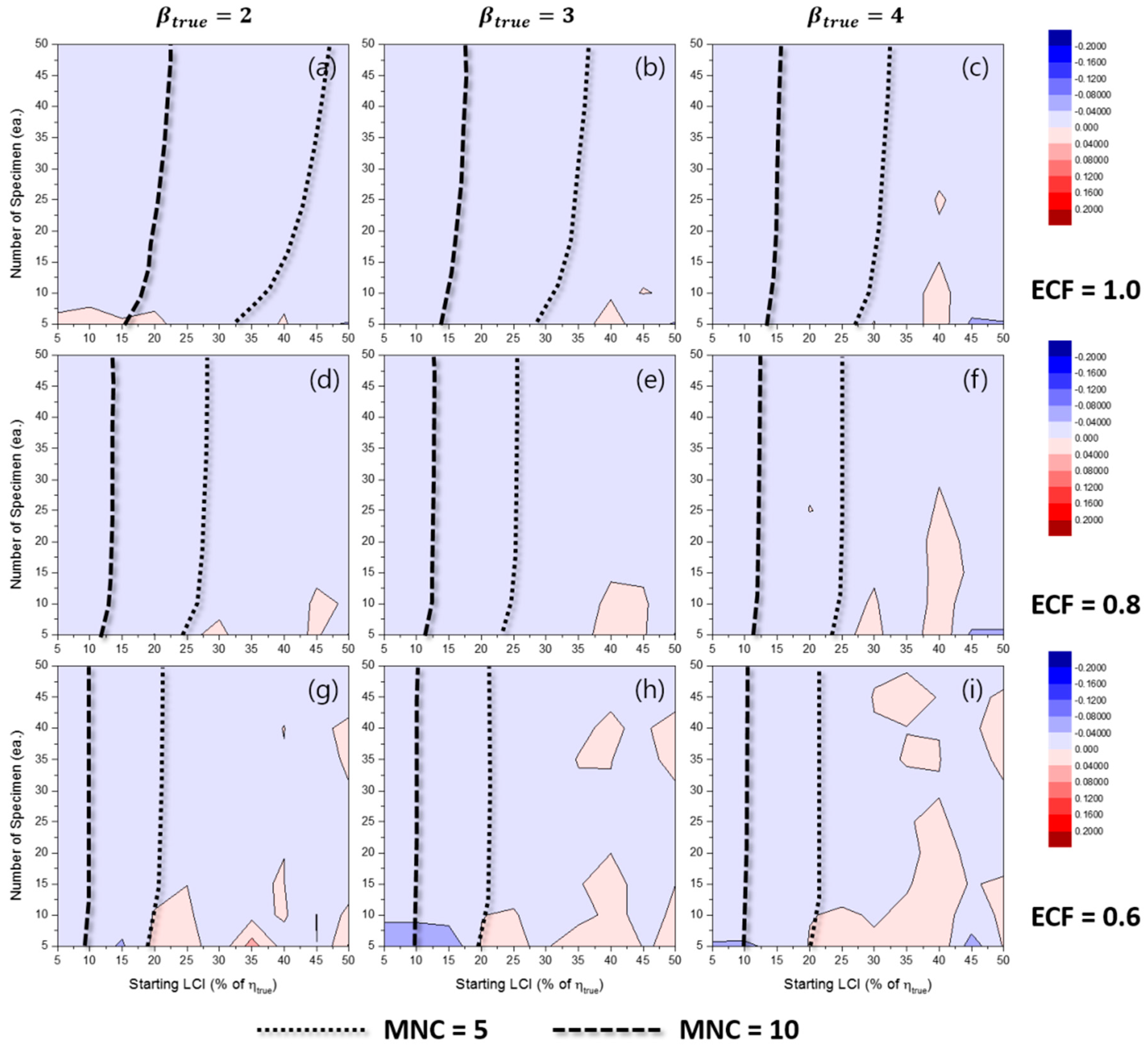

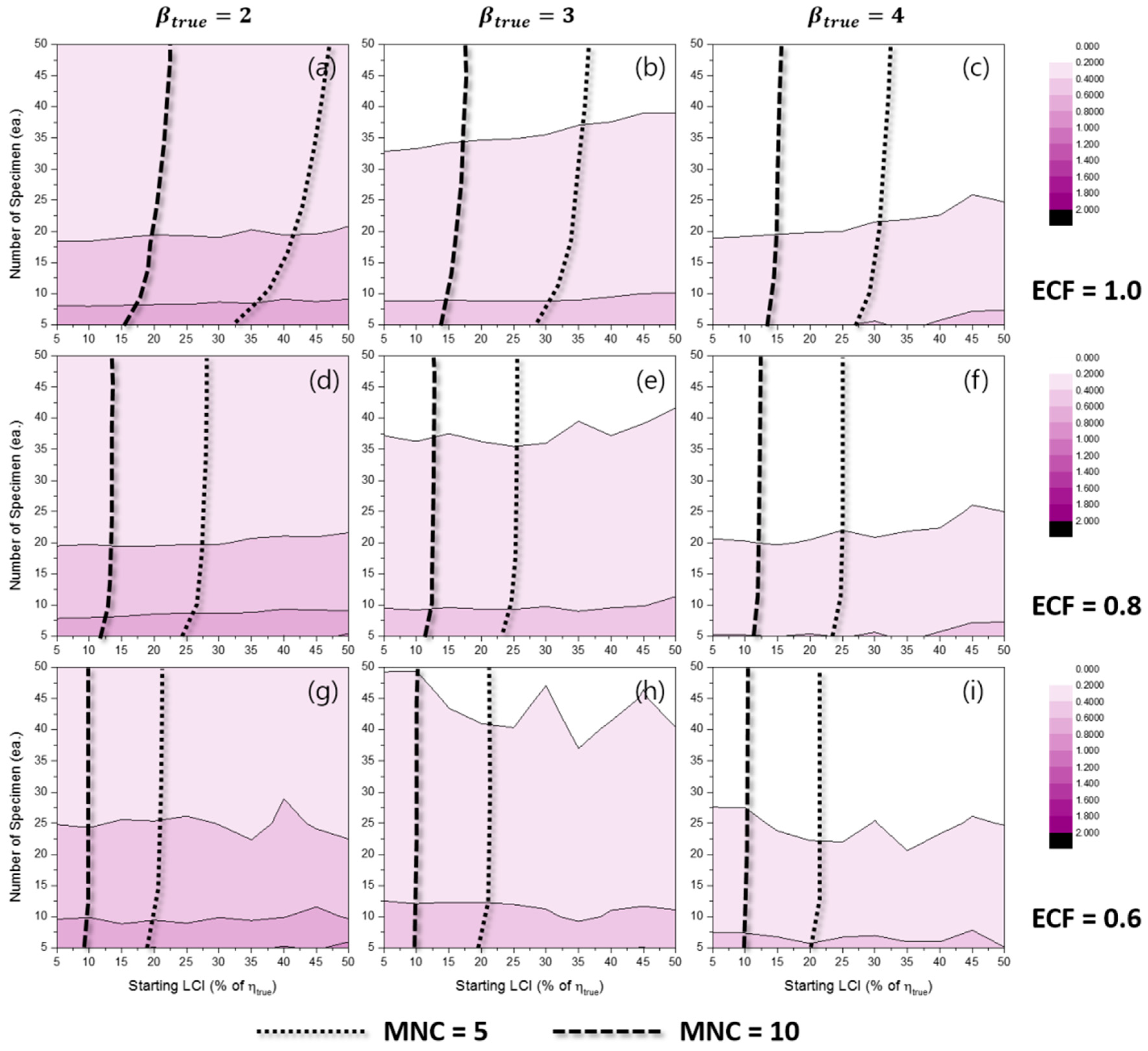
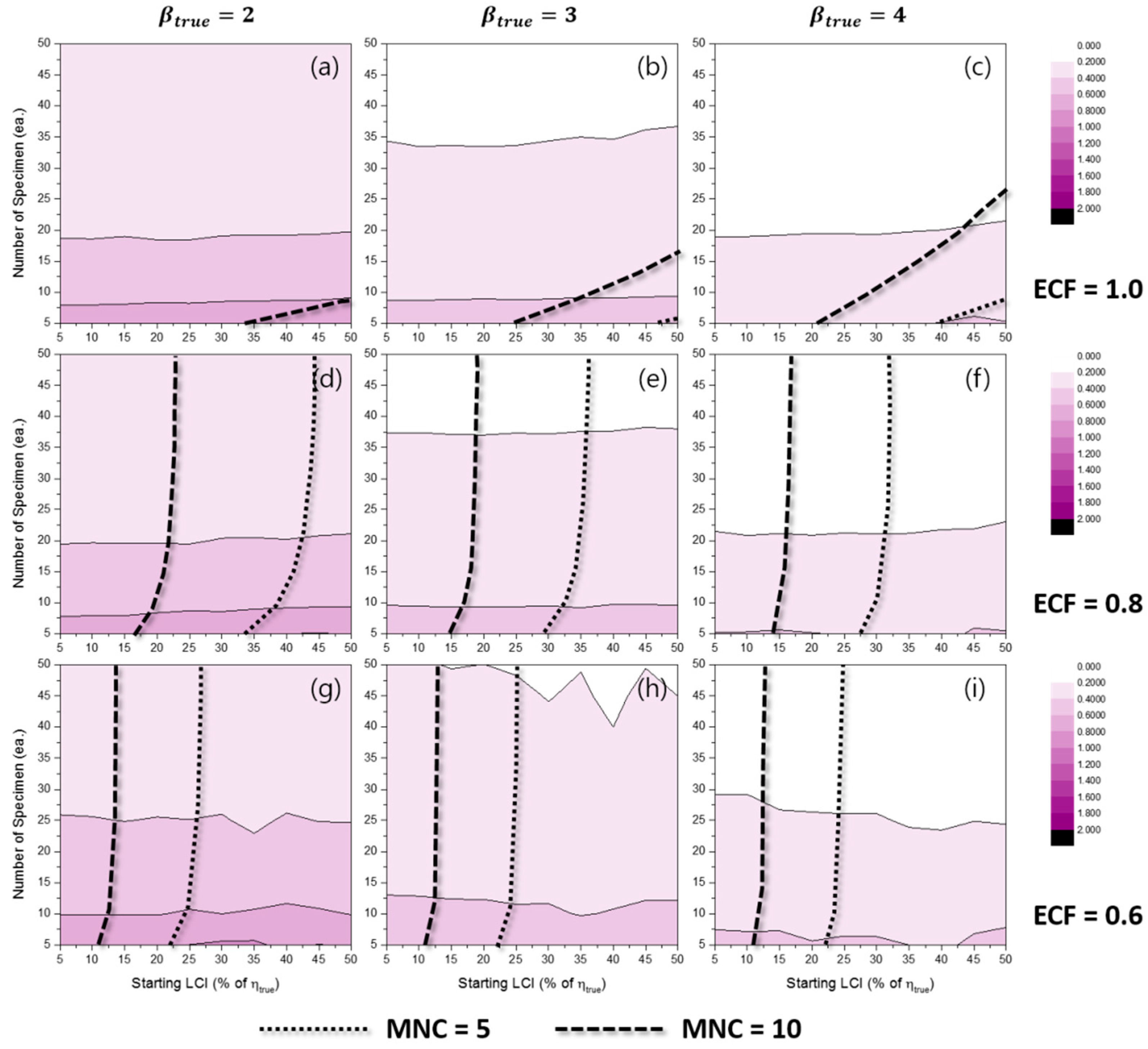
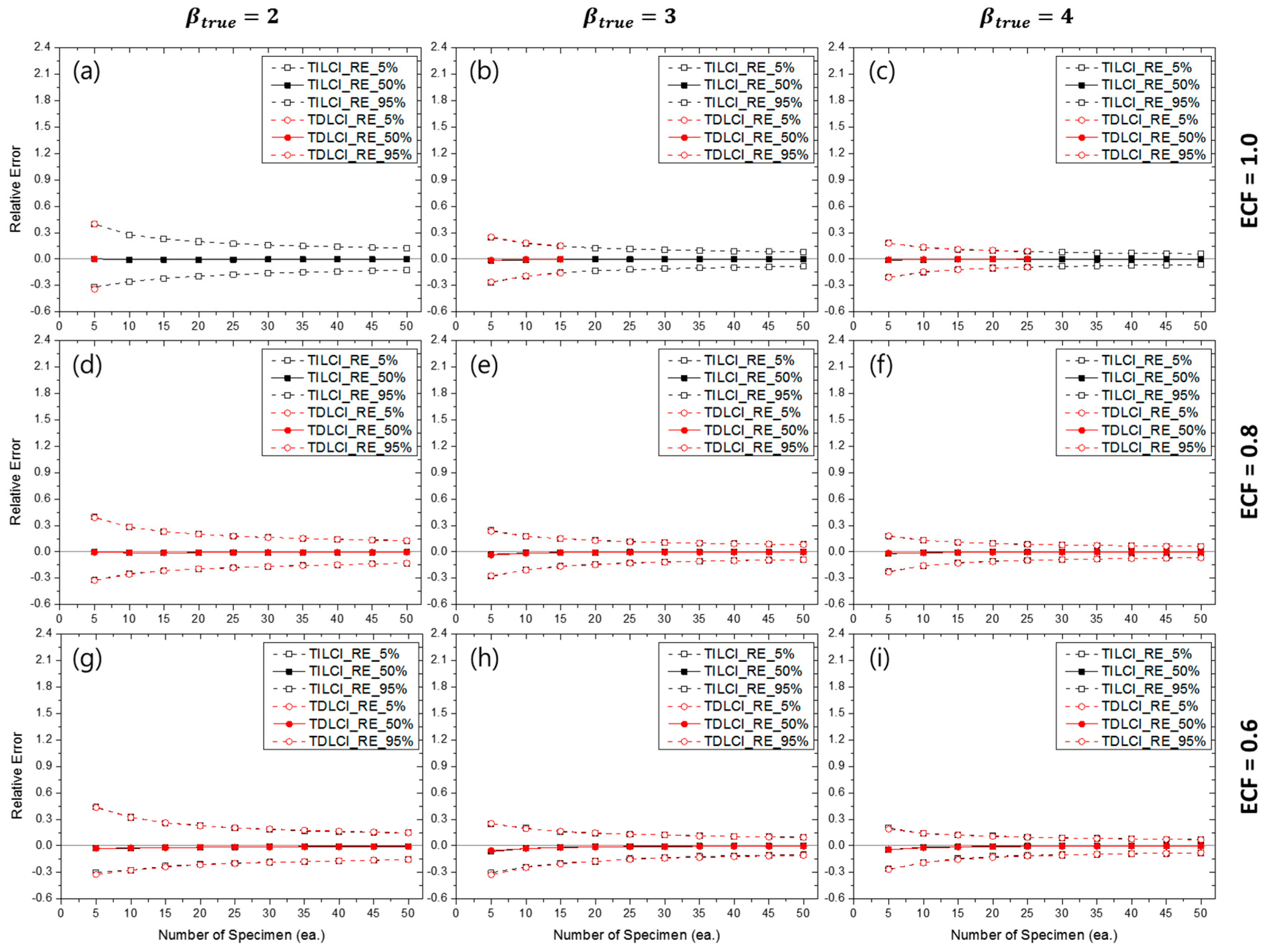
| Number of Survived Specimen | 10 | 10 | 6 | 3 | 3 | 2 | 0 | ||||||
| Survived Fraction | 1.0 | 1.0 | 0.6 | 0.3 | 0.3 | 0.2 | 0 | ||||||
| LCI (% of ) | 40 | 40 (=40 × 1.0) | 24 (=40 × 0.6) | 12 (=40 × 0.3) | 12 (=40 × 0.3) | 8 (=40 × 0.2) | |||||||
| Censoring Time (% of ) | 0 | 40 (=0 + 40) | 80 (=40 + 40) | 104 (=80 + 24) | 116 (=104 + 12) | 128 (=116 + 12) | 136 (=128 + 8) |
| True Weibull Parameters | Number of Specimens | ECF | LCI | ||
|---|---|---|---|---|---|
| (Dimensionless Time) | Starting LCI (% of ) | Time Dependence of LCI | |||
| 100 | 2 | 5 | 0.6 | 5 | Time independent |
| - | 3 | 10 | 0.8 | 10 | Time dependent |
| - | 4 | 15 | 1.0 | 15 | - |
| - | - | 20 | - | 20 | - |
| - | - | 25 | - | 25 | - |
| - | - | 30 | - | 30 | - |
| - | - | 35 | - | 35 | - |
| - | - | 40 | - | 40 | - |
| - | - | 45 | - | 45 | - |
| - | - | 50 | - | 50 | - |
| True Weibull Parameters | Number of Specimens | ECF | LCI | ||
|---|---|---|---|---|---|
| (Dimensionless Time) | Starting LCI (% of ) | Time Dependence of LCI | |||
| 100 | 3 | 10 | 1.0 | 40 | Time dependent |
© 2016 by the authors. Licensee MDPI, Basel, Switzerland. This article is an open access article distributed under the terms and conditions of the Creative Commons Attribution (CC-BY) license ( http://creativecommons.org/licenses/by/4.0/).
Share and Cite
Park, J.P.; Park, C.; Cho, J.; Bahn, C.B. Effects of Cracking Test Conditions on Estimation Uncertainty for Weibull Parameters Considering Time-Dependent Censoring Interval. Materials 2017, 10, 3. https://doi.org/10.3390/ma10010003
Park JP, Park C, Cho J, Bahn CB. Effects of Cracking Test Conditions on Estimation Uncertainty for Weibull Parameters Considering Time-Dependent Censoring Interval. Materials. 2017; 10(1):3. https://doi.org/10.3390/ma10010003
Chicago/Turabian StylePark, Jae Phil, Chanseok Park, Jongweon Cho, and Chi Bum Bahn. 2017. "Effects of Cracking Test Conditions on Estimation Uncertainty for Weibull Parameters Considering Time-Dependent Censoring Interval" Materials 10, no. 1: 3. https://doi.org/10.3390/ma10010003







